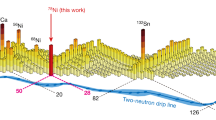Abstract
ULBRICHT'S suggestion1 that naturally occurring dissymmetry at the elementary particle level may be responsible for the chirality of molecules in the biosphere has feeen subjected to laboratory tests using polarised electrons2,3 and muons4. Some positive results are claimed to result from β− and β+ radiations2,3. Garay found a higher radiation yield for the decomposition of D-tyrosine than for L-tyrosine when subjected to intrinsically ‘left-handed’ β− particles from 90Sr in dilute aqueous solution. Since 2.26-MeV β− particles each create ∼ 105 secondary electrons during their energy degradation, the direct chemical consequences of the primary particle itself should be trivial. This suggests that dissymmetry must be transmitted through secondary chemical reactions. In the positron and muon experiments the ultimate fate of the individual polarised particles were studied in pure crystalline chiral media and in these cases the particle eventually abstracts an electron from the medium, principally while it is still epithermal.
This is a preview of subscription content, access via your institution
Access options
Subscribe to this journal
Receive 51 print issues and online access
$199.00 per year
only $3.90 per issue
Buy this article
- Purchase on Springer Link
- Instant access to full article PDF
Prices may be subject to local taxes which are calculated during checkout
Similar content being viewed by others
References
Ulbricht, T. L. V., Q. Rev. chem. Soc., 13, 48–60 (1959).
Garay, A. S., Nature, 219, 338–340 (1968).
Garay, A. S., Keszthelyi, L., Demeter, I. and Hrasko, P., Nature, 250, 332 (1974).
Lemmon, R. M., et al., Nature, 252, 692–694 (1974).
Kenney, G. A., and Walker, D. C., J. chem. Phys., 50, 4074–4081 (1969).
Kenney-Wallace, G. A., Shaede, E. A., Walker, D. C., and Wallace, S. C., Int. J. rod. Phys. Chem., 4, 209–225 (1972).
Hayward, L. D., and Totty, R. N., Chem. Commun., 676–677 (1969); Can. J. Chem., 49, 624–631 (1971).
Lai, M. W., thesis, Univ. British Columbia, Vancouver (1970).
Author information
Authors and Affiliations
Rights and permissions
About this article
Cite this article
ULRICH, M., WALKER, D. Search for selectivity in interactions of chiral solvated electrons. Nature 258, 418–419 (1975). https://doi.org/10.1038/258418a0
Received:
Accepted:
Issue Date:
DOI: https://doi.org/10.1038/258418a0
This article is cited by
-
The origin and amplification of biomolecular chirality
Origins of life and evolution of the biosphere (1991)
-
The asymmetry of life
Journal of Molecular Evolution (1978)
-
Polarized bremsstrahlung not the source of optical activity
Origins of Life (1976)
Comments
By submitting a comment you agree to abide by our Terms and Community Guidelines. If you find something abusive or that does not comply with our terms or guidelines please flag it as inappropriate.



